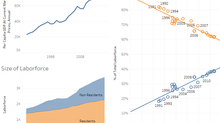How Much Can Generative AI Take Over the Tasks of a Data Analyst?

In recent years, generative AI (GenAI) has made remarkable strides, revolutionizing various fields with its advanced capabilities. As AI technology continues to evolve, a common concern arises: Will data analysts lose their jobs to AI? The short answer is no. While GenAI can automate many aspects of data analysis, the role of a human data analyst remains indispensable. Let’s explore what GenAI can and cannot do in the realm of data analysis, and how it can serve as a powerful ally rather than a replacement.
What GenAI Can Do
1. Automating Routine Data Processing Tasks
Data Cleaning: GenAI can automate the tedious task of cleaning datasets by identifying and correcting errors, removing duplicates, and handling missing values. For example, AI tools can automatically detect outliers and suggest corrections, saving analysts countless hours.
Data Transformation: Data Cleaning: AI can assist in transforming data from various sources into a unified format. Tools like AI-based ETL (Extract, Transform, Load) processes can streamline data integration from multiple databases.
2. Generating Descriptive Analytics
Summary Statistics: GenAI can quickly generate summary statistics such as mean, median, mode, standard deviation, and more, providing a quick overview of the data.
Data Visualization: AI can create complex data visualizations such as histograms, bar charts, and scatter plots, allowing for easy interpretation of data trends and patterns.
3. Performing Predictive Analytics
Predictive Modeling: AI can build and train predictive models to forecast future trends based on historical data. For example, it can predict customer churn, sales forecasts, and market trends with a high degree of accuracy.
Anomaly Detection: AI systems can continuously monitor data to detect anomalies and unusual patterns that might indicate fraud or operational issues.
4. Natural Language Processing (NLP)
Text Analysis: GenAI can analyze large volumes of text data to extract meaningful insights. It can perform sentiment analysis, topic modeling, and keyword extraction, making sense of unstructured data.
What GenAI Cannot Do (Yet)
Contextual Understanding
Business Context: While AI can analyze data, it often lacks the business context needed to interpret results meaningfully. Human analysts bring a deep understanding of industry-specific knowledge and business processes, which is crucial for making informed decisions.
Nuanced Judgement: AI struggles with nuanced judgement calls that require a deep understanding of company culture, market dynamics, and stakeholder interests.
2. Strategic Decision-Making
Hypothesis Generation: AI can test hypotheses, but it often requires human ingenuity to generate innovative hypotheses based on subtle market signals and intuition.
Actionable Insights: While AI can highlight patterns and trends, translating these insights into actionable business strategies often requires human intervention.
3. Ethical Considerations
Bias Mitigation: AI models can inadvertently perpetuate biases present in training data. Human oversight is essential to identify and mitigate these biases to ensure fair and ethical use of AI.
Ethical Judgement: Deciding on ethical considerations and the implications of data-driven decisions is a fundamentally human task. Analysts need to evaluate the broader impact of their recommendations.
4. Interpersonal Skills
Communication: Presenting data findings in a clear and persuasive manner is a key skill of human analysts. AI can generate reports, but the ability to tailor presentations to different audiences and address questions on the fly is uniquely human.
Collaboration: Data analysts often work in teams, collaborating with other departments to ensure that data insights align with organizational goals. This level of collaboration and relationship-building is beyond AI’s current capabilities.
The Future of Data Analysis: Collaboration Between AI and Humans
Rather than replacing data analysts, GenAI is poised to become a powerful tool that enhances their capabilities. By automating routine tasks and providing advanced analytical tools, AI frees up analysts to focus on more strategic, value-added activities. The future of data analysis lies in a collaborative approach where AI handles the heavy lifting, and human analysts bring in their expertise, creativity, and strategic thinking.
Steps for Collaboration
Skill Development: Data analysts should focus on developing skills that complement AI, such as critical thinking, business acumen, and communication.
AI Integration: Organizations should integrate AI tools into their data analysis workflows, enabling analysts to leverage AI for routine tasks while focusing on strategic insights.
Ethical Training: Analysts should be trained in ethical considerations and bias mitigation to ensure responsible AI use.
Continuous Learning: Staying updated with the latest AI advancements and understanding their applications in data analysis will be crucial for future success.
Conclusion
Generative AI is transforming the field of data analysis, but it is not a replacement for human analysts. By understanding the strengths and limitations of AI, we can harness its power to enhance data analysis processes, drive strategic decisions, and create more value for organizations. The future is bright for those who embrace AI as a collaborative partner in the journey of data-driven decision-making.


























コメント